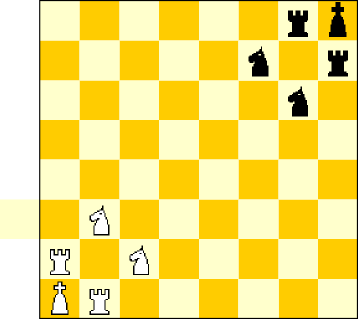Chess without pawns
Vladislav Rapetsky from St. Petersburg sent us this variant. One can easily play it with a standard chess set: treat the queen as a king, and ignore the pawns.Rules
Each player has two rooks, two bishops, two knights and two kings. The setup is as shown below, i.e., each piece is on the same starting square as in standard chess with the second king on the place of the queen. (There are no pawns or queens in this game).

Rooks, bishops and knight move without taking as in usual chess. They cannot take pieces. However, they do give check to the enemy kings.
Kings move like usual kings, i.e., one square in any direction. They may only take pieces of the opponent that are not protected.
Castling is possible under all rules of castling of usual chess. A king always castles to the nearby rook, when both have not yet moved, the king is not in check, the square passed over by the king is not attacked, and the square the king moves to is not attacked by the' opponent.
Kings may not move themselves into check, i.e., they may not move to a square that is attacked by a piece of the opponent. When at least one king is in check, a player must move such that this is no longer the case.
A player can win in two ways:
- By checkmating at least one king of the opponent, i.e., he has checked at least one king of the opponent, and the opponent has no move that lifts all checks to him.
- By taking one piece of the opponent (a rook, bishop or knight). Note that such a move must be done by a king and that the piece that is taken cannot be protected.
Repetition of moves is a draw (follow the rules of chess for this.)
A variant
The inventor gives also a variant with one king per player and a different setup.

White has a king on a1, rooks on a2 and b1, and knights on b3 and c2. Black has his king on h8, rooks on g8 and h7, and knights on f7 and g6.
Game was invented by Vladislav Rapetsky. Webpage made by Hans Bodlaender. Corrected a wrong rule interpretation on January 21, 2011.
WWW page created: January 14, 2011. Last modified on: January 21, 2011. The
